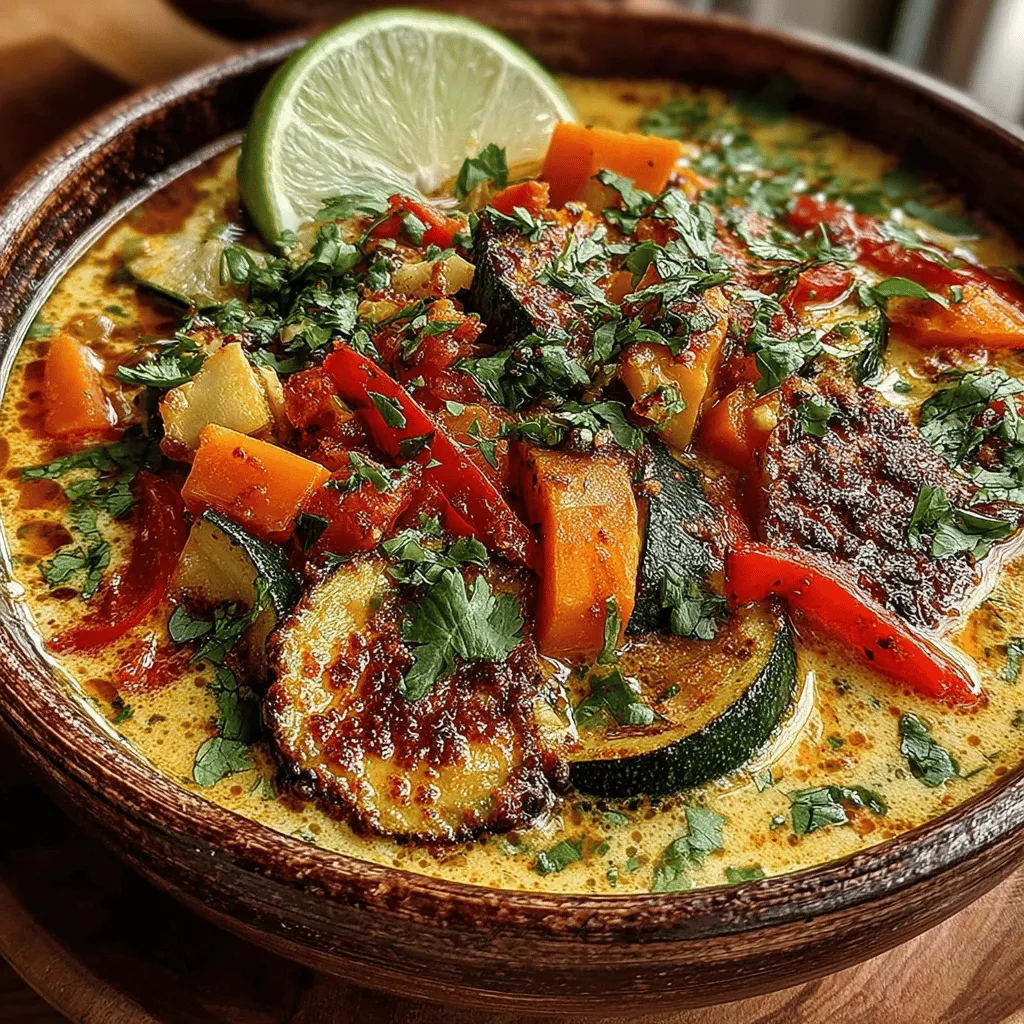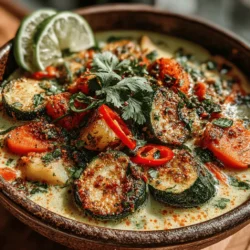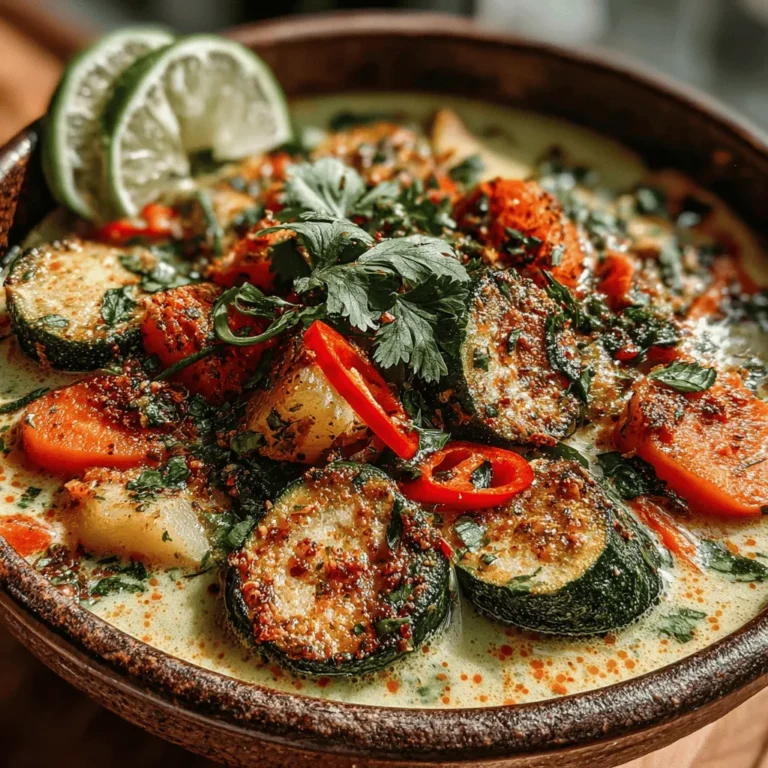Introduction
In recent years, plant-based meals have surged in popularity, appealing to those seeking healthier eating habits and environmentally friendly choices. The Tropical Bliss Crockpot Vegetable Curry stands out as a wholesome and vibrant dish that embodies the essence of tropical flavors. This recipe not only brings a splash of color to your plate but also offers a hassle-free cooking experience, thanks to the convenience of a crockpot. With minimal prep time and a blend of nutrient-rich ingredients, this curry supports a nourishing lifestyle while tantalizing your taste buds.
Ingredients
– 1 can (13.5 oz) coconut milk
– 2 cups vegetable broth
– 1 large onion, diced
– 4 cloves garlic, minced
– 1-inch piece fresh ginger, grated
– 1 bell pepper, diced (any color)
– 2 carrots, sliced
– 1 zucchini, diced
– 1 cup green beans, trimmed and cut into pieces
– 1 can (15 oz) chickpeas, drained and rinsed
– 2 tablespoons curry powder
– 1 teaspoon turmeric
– 1 teaspoon ground cumin
– 1 teaspoon chili powder (adjust to taste)
– Salt and pepper, to taste
– Fresh cilantro, for garnish (optional)
Instructions
1. Sauté the Aromatics: In a skillet over medium heat, add a splash of oil. Sauté the diced onion, minced garlic, and grated ginger until the onion becomes translucent and fragrant, about 5 minutes.
2. Combine Ingredients in Crockpot: Transfer the sautéed mixture to the crockpot. Add the coconut milk and vegetable broth, stirring to combine.
3. Add Vegetables and Chickpeas: Layer in the diced bell pepper, sliced carrots, diced zucchini, green beans, and chickpeas. Stir gently to mix everything evenly.
4. Season the Curry: Sprinkle in the curry powder, turmeric, cumin, chili powder, salt, and pepper. Stir well to ensure the spices are evenly distributed throughout the mixture.
5. Cook the Curry: Cover the crockpot and set it on low heat. Allow the curry to cook for 6-8 hours, or on high for 3-4 hours, until the vegetables are tender.
6. Adjust Seasoning: Once cooked, taste and adjust seasoning if necessary, adding more salt, pepper, or spices according to your preference.
7. Serve: Spoon the curry into bowls and garnish with fresh cilantro, if desired. This dish pairs well with rice or naan bread for a complete meal.
Understanding the Ingredients
Coconut Milk: The Creamy Base
Coconut milk serves as the rich and creamy base for this curry, adding depth and a subtle sweetness. It is not only delicious but also packed with healthy fats and essential vitamins, making it a fantastic ingredient for a balanced diet.
Vegetable Broth: The Flavorful Foundation
Vegetable broth is crucial in enhancing the flavor profile of the curry. It serves as a flavorful foundation that elevates the dish. You can choose between homemade broth, which offers fresher flavors, or store-bought options for convenience.
The Vegetable Medley
The vegetable medley in this curry is not only colorful but also loaded with nutritional benefits:
– Onion: Rich in antioxidants, onions enhance the flavor and provide health benefits.
– Garlic and Ginger: Both ingredients are known for their natural anti-inflammatory properties, adding warmth and zest to the dish.
– Bell Pepper: A vibrant addition, bell peppers are high in vitamins A and C, contributing both color and nutrition.
– Carrots, Zucchini, Green Beans: These vegetables are packed with essential vitamins and minerals, making the curry a wholesome choice.
The versatility of this dish allows for substitutions; feel free to use seasonal vegetables based on availability.
Chickpeas: The Protein Powerhouse
Chickpeas are a vital component of this plant-based recipe, providing a hearty source of protein and fiber. They help keep you satiated and are an excellent addition to any vegetarian or vegan diet.
Spices and Seasonings: The Aromatic Blend
The spices used in this curry—curry powder, turmeric, cumin, and chili powder—not only contribute to its aromatic quality but also offer a range of health benefits. Each spice plays a role in creating the rich flavor profile of the curry, making it a delightful dish for any occasion.
This Tropical Bliss Crockpot Vegetable Curry is a perfect representation of how easy it can be to enjoy delicious, healthy meals that transport you to a tropical paradise.

Importance of Sautéing Onions, Garlic, and Ginger for Flavor Development
Sautéing the foundational ingredients—onions, garlic, and ginger—before adding them to the crockpot is crucial for building a deep, rich flavor profile in your Tropical Bliss Crockpot Vegetable Curry. This step enhances the natural sweetness of the onions, mellows the sharpness of garlic, and activates the aromatic qualities of ginger, resulting in a more complex and satisfying curry.
Tips for Achieving the Perfect Sauté
1. Use the Right Pan: A heavy-bottomed skillet or sauté pan distributes heat evenly, preventing burning.
2. Oil Temperature: Heat the oil over medium heat until it shimmers; this ensures the ingredients cook evenly without burning.
3. Cut Evenly: Dice the onions and mince the garlic and ginger uniformly to ensure even cooking.
4. Patience is Key: Allow the onions to become translucent before adding garlic and ginger, which should be sautéed just until fragrant.
5. Scrape the Bottom: Stir frequently and scrape any browned bits from the bottom of the pan, as these add extra flavor to the curry.
Combining Ingredients in the Crockpot
To create a harmonious blend of flavors in your curry, layering ingredients properly is essential.
Step-by-Step Breakdown of Combining Ingredients
1. Base Layer: Start by adding the sautéed onions, garlic, and ginger to the bottom of the crockpot.
2. Vegetable Layer: Add heartier vegetables like carrots and potatoes first, followed by softer vegetables such as bell peppers and zucchini.
3. Spices and Liquids: Sprinkle in your spices, followed by the coconut milk and vegetable broth. This order helps to infuse the spices into the vegetables and ensures even cooking.
4. Final Touches: Add any delicate ingredients such as spinach or peas during the last hour of cooking to prevent them from becoming mushy.
Suggestions for Layering Ingredients for Optimal Flavor Infusion
– Consider adding whole spices like cinnamon sticks or bay leaves for depth.
– Layer in a mix of textures—crunchy vegetables and soft legumes—to enhance the eating experience.
– For a vibrant color contrast, use a variety of vegetables like yellow squash, green beans, and red bell peppers.
Cooking Time: Low and Slow vs. Quick and High
The choice between low and slow cooking versus a quick, high-heat method can drastically affect your curry’s flavor and texture.
Benefits of Cooking on Low for a Longer Time
– Flavor Development: Cooking slowly allows spices to meld and deepen, creating a more complex taste.
– Texture: Vegetables become tender but not mushy, retaining their shape and providing a satisfying bite.
– Convenience: Set it in the morning and return home to a fully cooked meal.
Discussing Cooking Methods
On the other hand, cooking on high heats up the dish quickly, making it suitable for last-minute meals but may sacrifice some flavor complexity and texture. If you’re in a rush, aim for a cooking time of 3-4 hours on high.
Final Adjustments for the Perfect Curry
As your curry nears completion, taste and adjust the seasoning to your liking.
Guide on Tasting and Adjusting Seasonings
– Salt and Spice: Start with small amounts of salt and spice, gradually increasing until you reach your desired flavor.
– Acidity and Sweetness: A squeeze of lime juice can brighten flavors, while a touch of sugar can balance spiciness.
Tips for Thickening the Curry
If you prefer a thicker curry, consider these options:
– Coconut Milk Reduction: Cook uncovered for the last 30 minutes to reduce the liquid.
– Cornstarch Slurry: Mix cornstarch with a little cold water and stir it into the curry during the last few minutes of cooking.
Serving Suggestions
Presentation Tips
A well-presented dish elevates the dining experience. Garnish your Tropical Bliss Curry with freshly chopped cilantro and a lime wedge for a pop of color and freshness.
Ideas for Serving Options
– Pair the curry with fluffy jasmine rice, nutty quinoa, or warm naan bread for a complete meal.
– Consider serving it in vibrant bowls to enhance the visual appeal.
Accompaniments and Pairings
Complement your curry with a light side salad tossed with a citrus vinaigrette or a cooling yogurt sauce to balance the heat.
Beverage Pairings
Serve with a refreshing mango lassi, iced tea, or a light white wine to round out the meal.
Health Benefits of Tropical Bliss Crockpot Vegetable Curry
This dish is not only delicious but also packed with nutritional benefits. With a medley of vegetables, it provides a variety of vitamins and minerals.
Overview of the Dish as a Nutritious, Balanced Meal
The Tropical Bliss Crockpot Vegetable Curry is a great source of fiber, vitamins, and minerals, making it ideal for a wholesome meal.
Emphasizing Dietary Needs
– Gluten-Free: Substitute soy sauce with tamari or coconut aminos for gluten-sensitive individuals.
– Vegan-Friendly: Made entirely from plant-based ingredients, this curry is perfect for vegans and vegetarians.
Incorporating this dish into your diet can support overall well-being, offering a tasty way to meet your nutritional needs.
Conclusion
In summary, the Tropical Bliss Crockpot Vegetable Curry is a simple yet nutritious recipe that fits seamlessly into any meal plan. Its versatility allows for customization based on personal preferences and dietary needs. With its vibrant flavors and easy preparation, this curry is a delightful addition to your weekly cooking routine. Explore and enjoy the rich, tropical flavors, and make this dish a staple in your kitchen.


